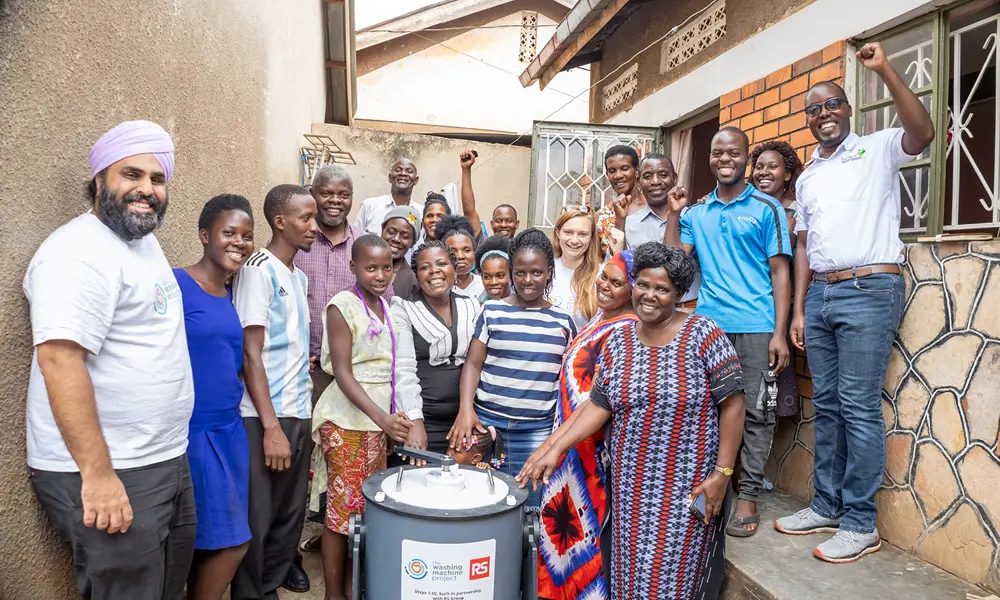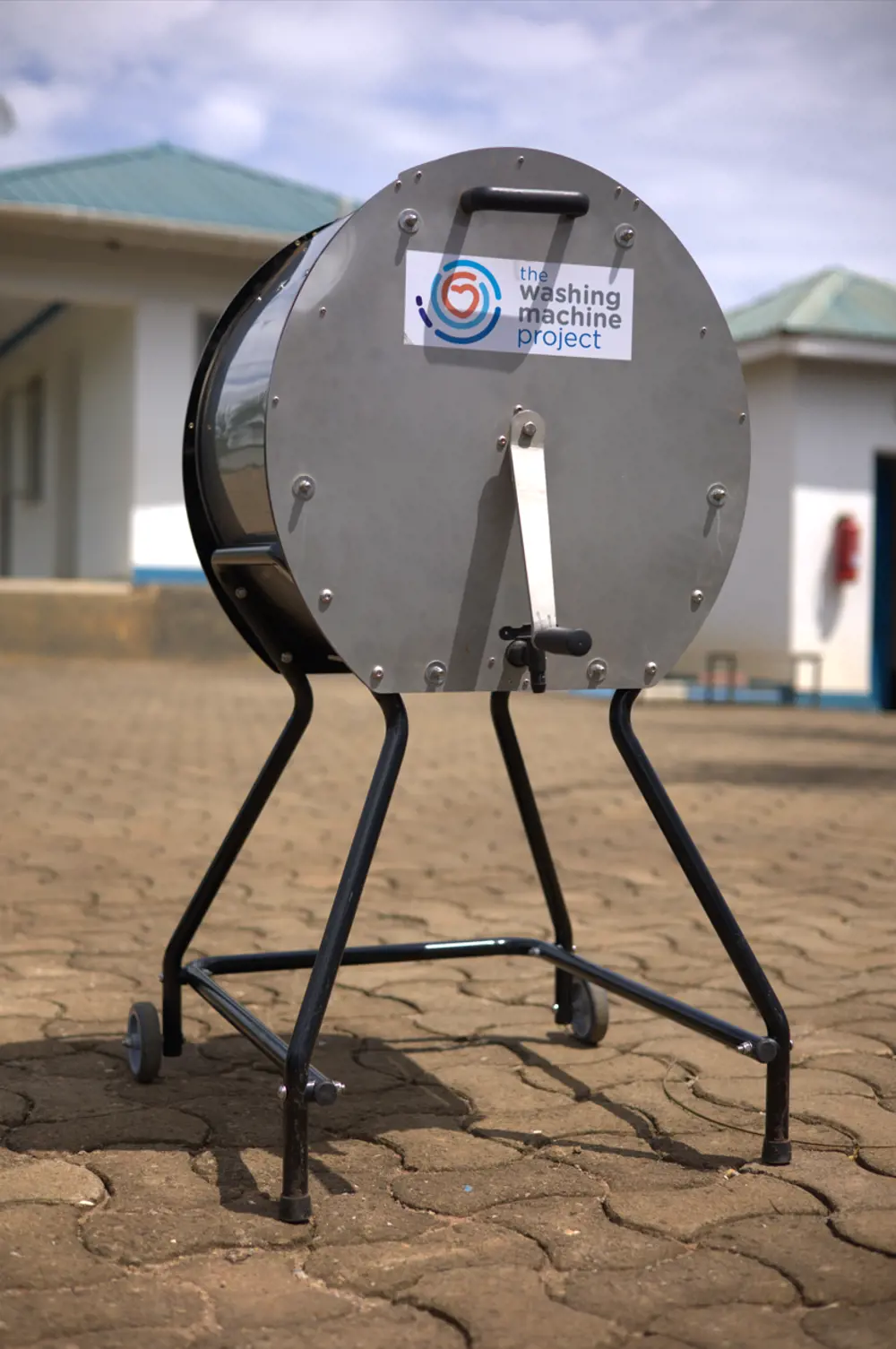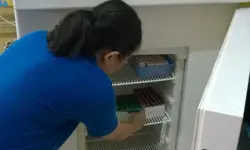
The manual washing machine for low-income communities
It’s easy to take washing machines for granted. But all around the world, doing the washing each week can add up to an arduous 20-hour job that’s disproportionately done by women. Aside from the huge time commitment, it’s tough on the hands, the back and the legs.
“You've got your hands submerged in detergent and water, which isn't great for the skin, and you're physically rubbing clothes against your skin in those conditions for hours on end,” explains Laura Tuck, R&D Team Lead at The Washing Machine Project. “The back ache, standing in the sun for hours – there's a lot of knock-on physical and health impacts from having to do that.”
The company’s Founder and CEO, Navjot Sawhney, was inspired to build the original prototype when working in India with Engineers Without Borders UK. He saw his neighbour Divya struggling with her washing and was driven to create a solution for her and others in low-income and displaced communities.
“The need is far greater than I think a lot of people realise,” says Laura. “Actually, 70% of the world's population – about 5.6 billion people – don't have access to a washing machine."
@thewashingmachineproject More people need to talk about the pain women face to do basic everyday tasks like laundry! #laundry #clean #fyp ♬ Aesthetic - Tollan Kim

The latest update to The Washing Machine Project's Divya hand-cranked washing machine, which can be fully operated standing up © The Washing Machine Project
Freeing up time – and water
In essence, The Washing Machine Project’s machine – named Divya, after Navjot’s neighbour – is a metal barrel with a handle to rotate it. It works in much the same way as an electric washing machine.
First, in go the clothes, water and detergent. Then, the user rotates the barrel for two minutes, before leaving the clothes to soak (and the detergent to get to work). They repeat this two or three times, depending on how heavily soiled the clothes are. Then, they empty out the water using a tap at the base of the barrel. This process is repeated with fresh water, for the rinse cycle.
The game-changing aspect is the combined mechanical and chemical action, from the rotation and the detergent. This means what would take an hour of handwashing takes a user less than 10 minutes of rotation. Unlike with handwashing, where people have to engage physically with the clothes the entire time, the manual machine enables people to multitask.
“When people are using the machine, they'll rotate it for one to two minutes and then they'll go and have a 10-minute break while the clothes are soaking.” Laura describes how some of their users take business meetings in these breaks. Others are seamstresses who can continue work on alterations, or parents spending time with their babies.
It even uses less water compared to handwashing (about 35 litres for a load): the design eliminates splashes or leaking, which waste water during hand washing. It also reduces the amount of rinsing needed by utilising mechanical action, and the tap allows the rinse water to be reused for other household chores.
Thanks to the combined mechanical and chemical action, what would take an hour of handwashing takes a user less than 10 minutes of rotation.
Building a better washing machine
The Washing Machine Project team has designed every element of the machine with the people who will ultimately use it in mind.
For example, its capacity is 5 kilograms (compared to about 9 kilograms for a standard electric machine). This balances the physical effort required to use it with the load size. “Obviously we have to consider [that] we don’t have a motor turning it, we have a human,” says Laura.
The original working prototype that Navjot designed in 2019 has also had an update. An open-source design, it was based on off-the-shelf parts: a blue plastic barrel and wooden frame. But the team was keen to improve the design. They had to reduce the force required from the user, eliminate leaking and improve the cleaning performance.
As engineers, they iterated on the design to address these issues. At the same time, they came up with other ways to make it cheaper, easier for people to use, and easier to ship and repair.
The update is designed so everything from loading clothes to rotating the handle can be done standing (as bending down repeatedly can be taxing). People can even operate it with one hand – in case they are holding a baby or breastfeeding.
It comes as a flat-pack kit designed to be put together and taken apart with “two spanners and some allen keys”. Crucially, no further tools or specialist skills are needed. “[It] could be made in the country and easily repaired,” says Laura, “rather than relying on a supply chain of spares and mechanics trained specifically for our machine.”
Barrel shapes usually require a lot of tooling to make and must be shipped full of air. However, this drum is formed from very thin sheets of metal that can bend “like you’d bend a bit of cardboard,” Laura explains. “It’s very flexible, and then once it’s bolted together, it becomes very rigid.
This drum is formed from very thin sheets of metal that can bend “like you’d bend a bit of cardboard".
“There are small tabs you can bend over with your thumb, and that holds it all together.” These can even be bent back up again to disassemble the machine. Then, to tighten everything up (and ensure no leaks), there are tie rods, nuts and bolts that can be fixed in place with a spanner.
Unlike most electric machines, the door is on top. This prevents leaking as it is above the waterline – also meaning no silicon seal is required. The joins below the waterline are reliably sealed by the compression created by the tightly fixed nuts and bolts.
Scaling up impact
Much of The Washing Machine Project’s progress has been made possible by a community of supporters, including corporate partners such as manufacturer RS Group, which provides financial support and volunteer employees’ time.
So far, machines have been sent to a wide range of countries, including Uganda, Ukraine, Iraq, Lebanon, India, and Mexico. “We’re going into large batch production very soon,” says Laura. And the team is considering developing a range of models, for larger families or more communal settings.
According to The Washing Machine Project’s estimates, the Divya has already impacted over 21,800 people. As the team continues to grow and gain accolades – including a 2024 Earthshot Prize nomination and a 2023 Points of Light award for Navjot – that number is sure to climb.
Keep up-to-date with Ingenia for free
SubscribeRelated content
Design & manufacturing

Super cool(er)
Welsh startup Sure Chill has developed a cooler that uses the properties of water to keep its contents cool for around 10 days without electricity. This is ideal for storing items such as vaccines where electricity sources are unreliable.

R&D investment makes good business sense
In just five years, Dr Ralf Speth FREng has presided over a revolution in design and manufacturing that has helped create a new family of engines and has overhauled Jaguar Land Rover (JLR) production facilities.

Steel can arise from the ashes of coal
Thousands of people were laid off in the UK steel industry in 2015 and there are pessimistic future forecasts. Professor Sridhar Seetharaman of the Warwick Manufacturing Group argues that smaller, flexible steel mills implementing new technology would better cope with fluctuating global trends.

Integrating metrology in business and academe
Professor Jane Jiang’s interest in measuring began when she worked on a bus production line in China. She found that the best way to improve quality, consistency and productivity was through metrology, the science of measurement. Today, she runs the UK’s largest metrology research group.
Other content from Ingenia
Quick read

- Environment & sustainability
- Opinion
A young engineer’s perspective on the good, the bad and the ugly of COP27

- Environment & sustainability
- Issue 95
How do we pay for net zero technologies?
Quick read

- Transport
- Mechanical
- How I got here
Electrifying trains and STEMAZING outreach

- Civil & structural
- Environment & sustainability
- Issue 95